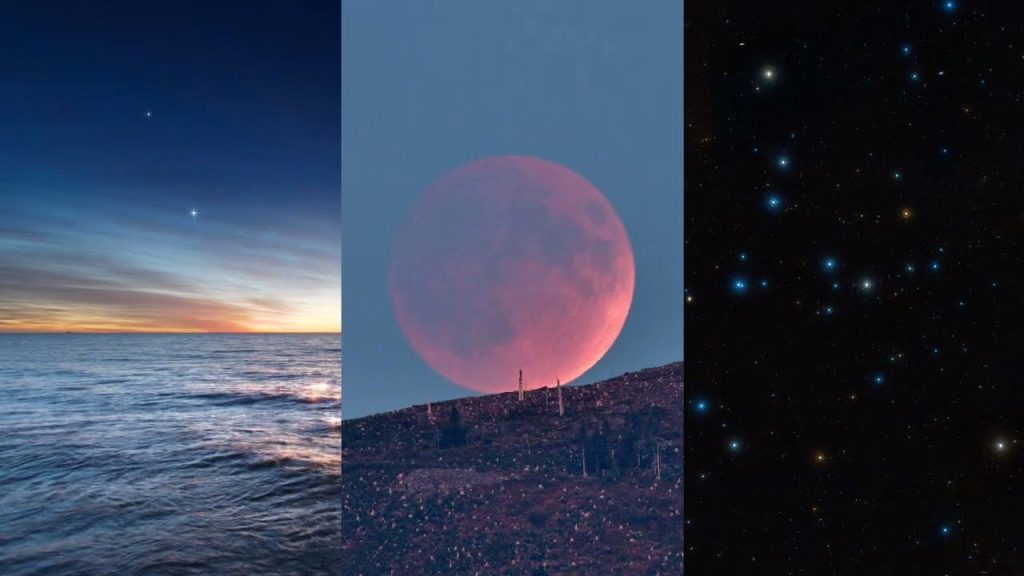
O que há para maio? Planetas crepúsculo e amanhecer, eclipse lunar e aglomerado de estrelas em coma.
Gráfico do céu Mercúrio aparece baixo no céu ocidental em 2 de maio, acompanhado por uma lua crescente e a estrela brilhante Aldebaran. Crédito: NASA/JPL-Caltech
Pode começar e terminar com duas grandes oportunidades para descobrir o planeta. Em 2 de maio, olhe para oeste cerca de 45 minutos após o pôr do sol para encontrar Mercúrio a cerca de 10 graus do horizonte, acompanhado por uma fina lua crescente. Ao sul da lua está a estrela gigante vermelha brilhante Aldebaran, que deve ter aproximadamente o mesmo brilho de Mercúrio. (A propósito, esta é a única chance de localizar um planeta a olho nu no início da noite até agosto.)

O gráfico do céu mostra como Júpiter e Marte aparecerão muito próximos no céu da manhã de 28 a 30 de maio. Crédito: NASA/JPL-Caltech
Então, na última semana de maio, você pode assistir todas as manhãs como[{” attribute=””>Jupiter and Mars get increasingly close in the predawn sky. Their morning meetup culminates in a close conjunction that you can watch on the 28th through the 30th, where they’ll be separated by barely the width of the full moon. Should look incredible with binoculars, where you can also see Jupiter’s largest moons.
Skywatchers in the Western Hemisphere can look forward to a total lunar eclipse in mid-May. The event will be visible across the Americas, Europe, and Africa – basically anywhere the Moon is above the horizon at the time.
The visible part of the eclipse begins about 10:30 p.m. U.S. Eastern time on May 15th, with totality starting an hour later and lasting for about an hour and a half. Those in the Eastern U.S. will see the eclipse start with the Moon well above the horizon. For the Central U.S., the eclipse starts about an hour and a half after dark, with the Moon relatively low in the sky. On the West coast of the U.S., the Moon rises with totality beginning or already underway, so you’ll want to find a clear view toward the southeast if viewing from there.
Now, lunar eclipses are the ones that are safe to look at directly with your eyes, binoculars, or a telescope (unlike solar eclipses).
The Moon takes on a dim, reddish hue during the period of totality. Even though the Moon is fully immersed in Earth’s shadow at that time, red wavelengths of sunlight filter through Earth’s atmosphere and fall onto the Moon’s surface. One way to think of this is that a total lunar eclipse shows us a projection of all the sunrises and sunsets happening on the planet at that moment.
So check your local details for this eclipse, and find lots more eclipse info from NASA at this link.
Finally in May, a really nice target for binoculars: the Coma star cluster. This loose, open star cluster displays 40 or 50 stars spread over a region of sky about three finger-widths wide. The brightest stars in the cluster form a distinctive Y shape, as seen here.

Sky chart showing where to find the Coma star cluster in May. The cluster is about 6° wide, and is located about 15° east of the hindquarters of Leo, the lion constellation, which is found high overhead in the south. Credit: NASA/JPL-Caltech
The Coma star cluster is located about 300 light-years away, making it the second-closest open cluster to Earth after the Hyades cluster in Taurus.
To find the Coma star cluster, look southward for the constellation Leo. It can be easiest to start from the Big Dipper, toward the north, and use the two “pointer stars” on the end which always point you toward Leo. Once you’ve identified Leo, the Coma star cluster is about 15 degrees to the east of the triangle of stars representing the lion’s hindquarters. It’s relatively easy to find with binoculars, even under light-polluted urban skies – as long as it’s clear out.
So here’s wishing you clear skies for finding the Coma star cluster and any other wonders you discover in the night sky in May.

“Encrenqueiro. Viciado em mídia social. Aficionado por música. Especialista em cultura pop. Criador.”





More Stories
O núcleo de Plutão foi provavelmente criado por uma antiga colisão
rápido! Alguém pegue este livro médico.
Escavações antigas levam à descoberta dos maiores répteis marinhos conhecidos